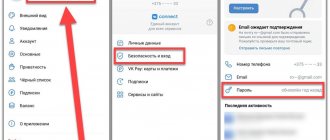Google Search
Browsing cached pages in Google begins the same way as any other Google search. Once you've entered a search query and see the results, click the arrow next to the URL and select the Saved Copy to view Google's most recently saved versions of the pages.
When the site loads, Google notifies you that this is an outdated version and indicates the date it was created. There is also an option to view only the text version of the page and the source code. You will not be able to navigate to other pages and still remain in the cache version. If you try to follow the link, the current version of the site will open.
What iconic sites looked like before
For example, let's look at what popular resources looked like before, namely Yandex, Google, YouTube, Wikipedia and VK. All of them have undergone dramatic design changes over time.
Search engine Yandex
The Yandex search engine was officially announced on September 23, 1997. More than 20 years have passed since then, and today it is one of the most popular search engines in the world.
In the web archive, the first saved copy is dated December 6, 1998.
At that time Yandex looked like this:
Google search engine
The Google search engine was founded a little later - in 1998. It is now the most popular search engine in the world.
The first saved copies appeared in the web archive at the end of 1998. For example, on December 2, Google looked like this:
YouTube
Youtube started its work in February 2005. The first copies saved in the web archive appeared at the end of April 2005. At that time, the service had a minimalistic design, and it was clear that it was nothing more than a video hosting service:
Wikipedia
Wikipedia appeared on January 15, 2001. Today it is the largest and most popular reference book on the Internet and contains more than 40 million articles that are available in 301 languages.
In the web archive, the first preserved copy of Wikipedia is dated July 27, 2001:
In contact with
The social network VKontakte, popular in Russia and other countries, was created on October 10, 2006.
In the web archive, the first saved copy of the site dates back to November 8, 2006. It shows that the site was initially aimed at students and graduates.
Wayback Machine
There are organizations that are trying to preserve the history of the Internet. The best-known such organization is the non-profit Internet Archive, which stores websites, text, video, audio, software and images that are difficult to find elsewhere. You can also view older versions of the website on the Wayback Machine.
Enter a URL and the archive search engine will display a calendar showing when the Wayback Machine saved the page. Click on a date on the calendar to see what the site looked like on that day. The Wayback Machine is a great way to study internet history.
Why do you need to look for old versions of sites?
The reasons why it may be necessary to view a site in the past tense can be completely different. Often this is a desire to immerse yourself in pleasant nostalgia. For example, see what popular platforms and social networks used to look like. Or see what your own website looked like a few years ago. Fortunately, there is a tool that allows you to do this, even if the resource itself is no longer available.
How is this possible? If a site exists on the Internet for at least a couple of days, it ends up in the web archive. The tool saves its code, so you can see what it looked like even many years ago.
Reasons why there is a need to look at portals in the past:
- Tracking history of changes. This need may arise for copywriters or journalists to prepare new content. This may also be necessary for analyzing competitors: you can trace the path of their development and see the mistakes made.
- Resource recovery. If the user forgot to renew the domain or did not make a backup, a web archive will be an excellent recovery option.
- Search for unique content. If a site is no longer available, its content becomes unique. You can use it in whole or in part, after checking its uniqueness.
- See the required content if the page is no longer available. For example, a user added a site to his bookmarks, but after a while it turned out that it no longer exists. Then you can view its contents only using the web archive.
Browser extensions
There are browser extensions for all occasions, including for accessing a cached version of the site.
Add the Web Cache Viewer extension to Chrome and right-click on any page to view the Google or Wayback Machine version. An extension called View Page Archive & Cache for Chrome or Firefox goes even further and allows you to view cached versions of web pages from numerous search engines such as Bing, Baidu, Yandex.
Is it possible to restore a site from a web archive?
If you lose data, you can restore your site using the site https://webarchiveorg.ru/. To do this you need:
- enter URL;
- select the desired year, month and day;
- Click the “Restore site” button.
The service is paid, so it is recommended that you familiarize yourself with the tariffs before restoring. The exact cost depends on the number of sites and its pages.
Saved copies of pages are not what is in the index
Since ancient times, SEO specialists have used a saved copy of a page in a search engine to analyze the indexing of changes made on the page. However, four years ago I noticed that in Yandex the saved copy may not coincide with the version of the page that is actually currently in the search index and is used in ranking. Today I would like to check whether the saved copy of Yandex can now be trusted. Well, and at the same time see how its main competitor in the domestic search market, Google, is doing with this.
For analysis, I will need a page that publishes the current date. By comparing the date that is in the saved copy with the date by which this page is in the search engine, and which can be shown in its snippet, we can conclude that the version of the page shown in the saved copy corresponds to the version of the page that is in the search index . For our purpose, the Yandex home page is perfect.
So, let’s first analyze the situation in Yandex itself by finding the Yandex main page using the documented url: with the request url:yandex.ru and opening its saved copy. We find the date in it (at the time of analysis it is “February 25, Monday, 22:23”):
So, let's try to find its main page in Yandex using the exact text phrase with this date. Alas, it was not possible to do this. We receive a message that no exact match was found:
It turns out that the search index contains a version of the Yandex main page from a different date. Using simple manipulations with changing the date in the search phrase, we make sure that the index contains an earlier version of the Yandex main page.
Unfortunately, Yandex did not deign to please us by showing a text match in the snippet (apparently, considering this text to be official and of little significance), however, the absence of the phrase “No exact match was found” eloquently indicates that this particular phrase is contained in the version of the page that is located currently in the search index:
Moreover, you can make sure that the saved copy in Yandex can have several versions displayed alternately. So, by updating a page with a saved copy of the main page in Yandex, we can from time to time see another version of it with a different date (in my case - “February 24, Sunday 22:37”), but still not matching the one for which the page is in the index:
So, the situation in Yandex has not changed. The saved copy still does not match the one in the index and participating in the ranking.
Well, what does Google think about this? The saved copy of the page can be viewed directly using the cache . We make a Google request cache:yandex.ru , get the saved file and find the date in it:
Unfortunately, the site: in Google, when applied to the main page of a site, shows results for the entire site, and upon request by date without time, we get quite a lot of pages from the site in the results (from the Yandex.Weather service, etc. .), which makes analysis difficult. But by adding time to the request, we make sure that the results for the exact phrase are empty:
In order to make it easier to find the date of the version located in the index, we will use one interesting technique.
Google has an operator for obtaining information about a page, info:, which shows a snippet of the specified page if it is present in the index. Unfortunately, this operator does not want to work correctly in conjunction with a search query, i.e. is not analogous to the site: . However, if we use a term to the right of this operator, then if there is an exact occurrence of it in the text of the page, we can see a snippet highlighting this term.
Using the name of the current month in the corresponding case as such a term, we get a display of the date in the snippet, and make sure that it does not coincide with the one contained in the save:
Let's check using a query for the exact phrase that the search index actually contains a version of the page with the specified date:
It is curious that in Yandex the version of the analyzed page in the saved copy is more recent than the version in the index, but in Google it is the other way around.
In total, as a result of a simple analysis, we are convinced that neither Yandex nor Google can be sure that the version of the page shown in the saved copy is used for ranking. And this fact must be taken into account when analyzing search results in order to avoid false conclusions.
How to view the web archive?
There is nothing complicated about how to view a web archive. To do this, it is enough to know the addresses of the required resource. You need to go to the official archive.org page and enter the URL of the desired site. After this, the system will give you all the information it has about this resource.
By using a web archive, you can trace the development of company websites and find information that has disappeared from access. Perhaps after a while people will use it to find out what the challenge is for and what it is in 2021. It is for this, for the opportunity to learn the cultural and historical component of the Internet, that the project was awarded.
How to use the web archive?
There is nothing complicated about how to use the web archive. In order to use it, just go to the corresponding site archive.org and enter the address of the desired site in the search. After a short time, the archive will display information about the available saves of this resource.
For example, using this you can find information from a site that for some reason has ceased to exist. The web archive will also help you find information from pages, even if it has been deleted. This is especially important for finding successful examples of storytelling over the years. Let's take a closer look at how to view the archive.











